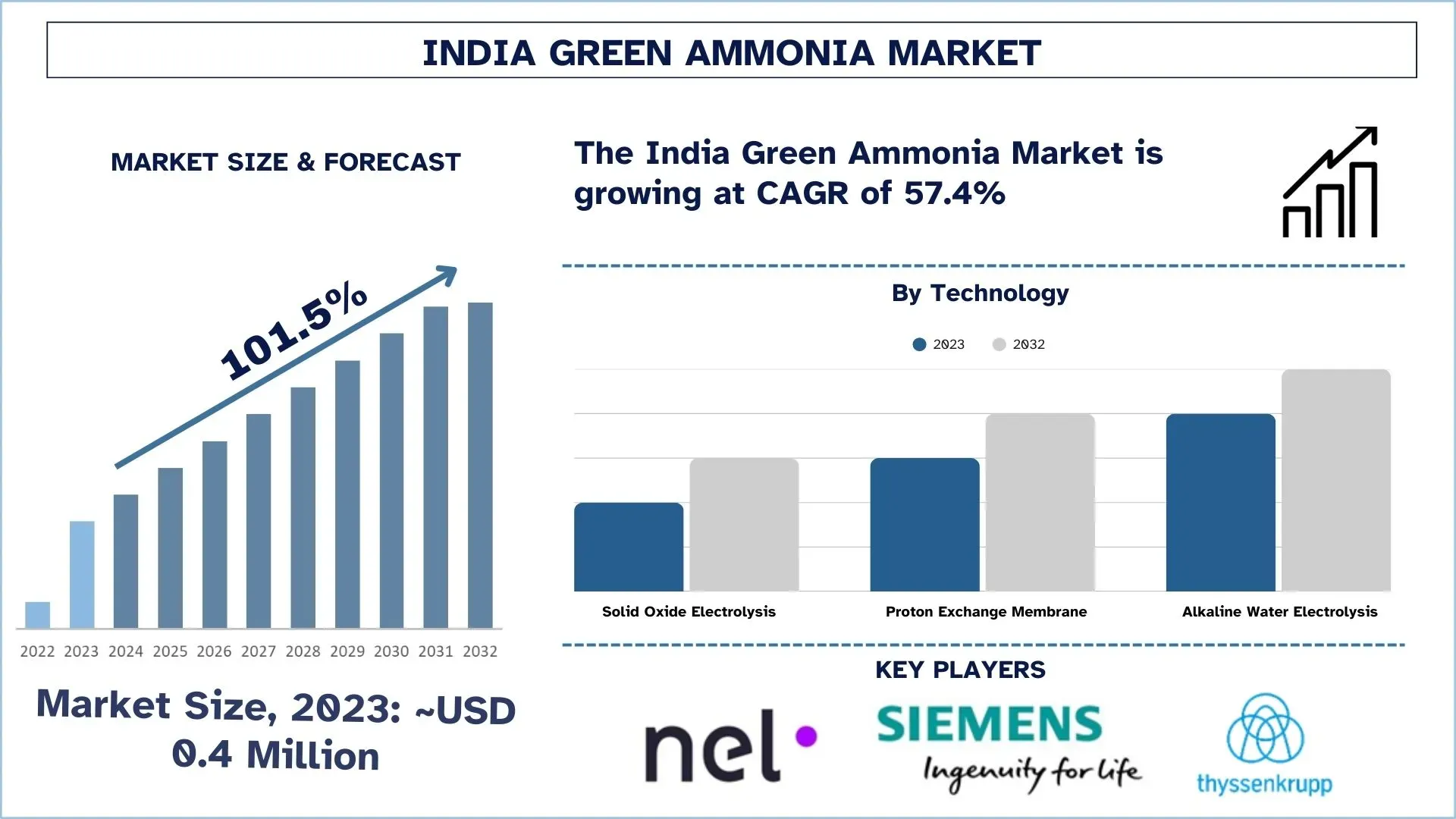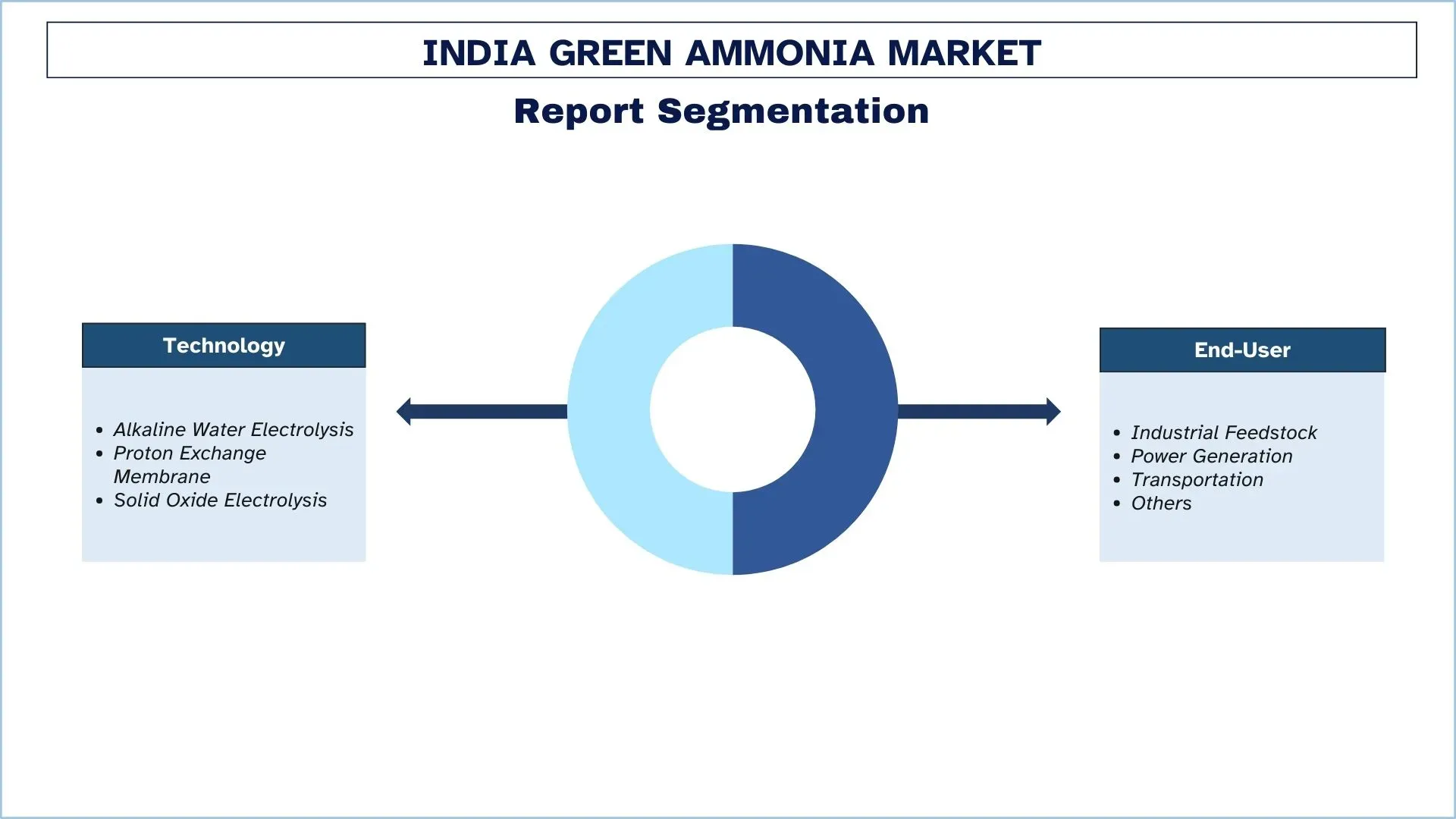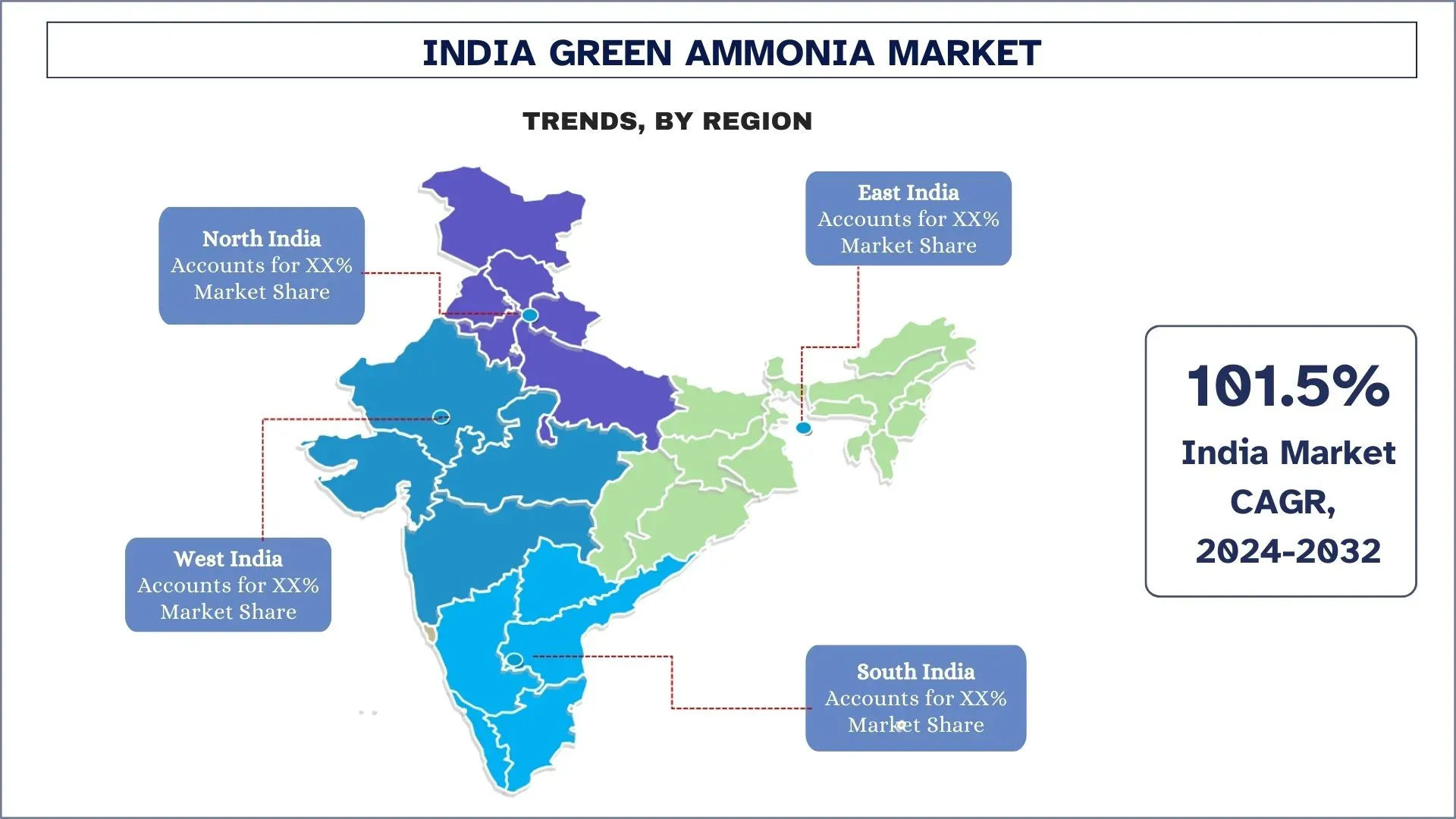Рынок зеленого аммиака в Индии: текущий анализ и прогноз (2024-2032 гг.)
Акцент на технологии (щелочной электролиз воды, электролиз с протонообменной мембраной и твердооксидный электролиз); и конечного пользователя (транспорт, производство электроэнергии, промышленное сырье и прочее)

Размер и прогноз рынка зеленого аммиака в Индии
Объем рынка зеленого аммиака в Индии оценивался в 0,4 млн долларов США, и ожидается, что в течение прогнозируемого периода (2024-2032 гг.) он будет расти с высокими темпами CAGR около 101,5% благодаря росту инвестиций в возобновляемые источники энергии.
Анализ рынка зеленого аммиака в Индии
Рынок зеленого аммиака в Индии в настоящее время находится на начальной стадии развития. Кроме того, отсутствуют мандаты со стороны спроса для поддержки его внедрения. Стимулирование развития рынка зеленого аммиака может помочь ускорить декарбонизацию Индии и позволить ей достичь целей энергетической независимости. Поэтому спрос на зеленый аммиак на начальном этапе будет определяться поддерживающей государственной политикой и внедрением технологий. В августе 2021 года Индия объявила о Национальной водородной миссии, являющейся ключевым элементом правительственного плана по достижению Индией энергетической независимости в течение 25 лет. Индия тратит 164 миллиарда долларов США в год на удовлетворение своих энергетических потребностей, причем большая часть этих средств тратится на импорт нефти, газа и угля. Кроме того, Индия предпринимает шаги для достижения своей цели по нулевым выбросам углерода к 2070 году, уделяя особое внимание зеленому водороду как потенциальному решению. Недавно страна объявила о своей Политике в отношении зеленого водорода, которая, как ожидается, значительно стимулирует этот сектор.
Тенденции рынка зеленого аммиака в Индии
В этом разделе обсуждаются ключевые тенденции рынка, влияющие на различные сегменты рынка зеленого аммиака в Индии, выявленные нашими экспертами-исследователями.
Растущее потребление удобрений
Численность населения мира растет, поэтому необходимо увеличить сельскохозяйственное производство для удовлетворения продовольственных потребностей растущего населения. Использование химических удобрений для повышения сельскохозяйственного производства стало широко распространенной практикой во всем мире. Кроме того, растет спрос на органические и экологически чистые удобрения. Органические удобрения изготавливаются из натуральных растительных остатков и отходов, животного навоза и экскрементов, микроорганизмов и ботанических экстрактов для повышения сельскохозяйственного производства. Таким образом, такие факторы, как растущая потребность в увеличении сельскохозяйственного производства и осведомленность о вредном воздействии химических веществ и преимуществах органических удобрений, увеличивают потребление различных экологически чистых удобрений.
Сегментация рынка зеленого аммиака в Индии
В этом разделе представлен анализ ключевых тенденций в каждом сегменте отчета о рынке зеленого аммиака в Индии, а также прогнозы по региональным уровням на 2024-2032 годы.
На рынке зеленого аммиака в Индии доминирует щелочной электролиз воды
На основе технологии рынок делится на щелочной электролиз воды, протонно-обменную мембрану и твердооксидный электролиз. Среди них в производстве зеленого аммиака доминирует щелочной электролиз воды, и ожидается, что эта тенденция сохранится и в течение прогнозируемого периода. Щелочной электролиз воды является одним из наиболее распространенных типов технологий, используемых для расщепления воды на газы водород и кислород, в котором используется раствор гидроксида калия (KOH) и никелевый катод, и он является наиболее широко используемым методом производства зеленого аммиака благодаря своей простоте, зрелости и экономической эффективности. Значительное предложение KOH и налаженная сеть поставщиков этого химического вещества снизили цены производства и улучшили масштабируемость. В то время как другие методы электролиза, включая протонно-обменную мембрану (PEM) и твердооксидный электролиз (SOE), демонстрируют перспективы, они сталкиваются с проблемами, касающимися более высоких рабочих температур, устойчивости к коррозии и проблем с масштабированием, что препятствует их массовому внедрению.
На рынке зеленого аммиака в Индии доминирует промышленное сырье
На основе конечных пользователей рынок сегментирован на промышленное сырье, производство электроэнергии, транспорт и т. д. Среди них в 2023 году доминировал сегмент промышленного сырья, и ожидается, что он будет доминировать и в течение прогнозируемого периода. Промышленное сырье, обычно получаемое из природного газа, обеспечивает хорошо налаженную цепочку поставок и инфраструктуру, что упрощает наращивание производства и удовлетворение высоких потребностей различных отраслей. Более того, центральная роль аммиака заключается в том, что он является основным сырьем для неорганических удобрений, которые в настоящее время поддерживают производство продовольствия примерно для половины населения мира. Около 70% аммиака используется для производства удобрений, а остальная часть используется для широкого спектра промышленных применений, таких как пластмассы, взрывчатые вещества и синтетические волокна. Во-вторых, цена производства зеленого аммиака из промышленного сырья обычно ниже по сравнению с различными возобновляемыми источниками, включая биомассу или солнечную энергию, что делает его более экономически целесообразным для массового производства.

Ожидается, что Северная Индия будет расти со значительным CAGR в течение прогнозируемого периода
Рынок зеленого аммиака в Северной Индии развивается быстрыми темпами благодаря растущей поддержке правительства в отношении чистой энергии, а также увеличению спроса на устойчивые удобрения и развитию водородной инфраструктуры в регионе. Штаты Пенджаб и Харьяна вместе с Уттар-Прадешем зарекомендовали себя как крупные центры, поскольку эти регионы сочетают в себе прочные сельскохозяйственные основы с активными программами по снижению своего углеродного следа. Расширение рынка аммиака, работающего на возобновляемых источниках энергии в Северной Индии, происходит за счет инвестиций в производство аммиака на основе возобновляемых источников энергии и партнерских отношений между энергетическими компаниями и лидерами государственной политики. Северный индийский регион может стать важным в движении Индии к низкоуглеродной экономике после того, как Национальная миссия по зеленому водороду выступила за использование зеленого аммиака в качестве средства транспортировки энергии.

Обзор отрасли зеленого аммиака в Индии
Рынок зеленого аммиака в Индии является конкурентным и фрагментированным, на нем присутствует несколько игроков. Ключевые игроки применяют различные стратегии роста для расширения своего присутствия на рынке, такие как партнерства, соглашения, сотрудничество, запуск новых продуктов, географическое расширение, слияния и поглощения. Некоторыми из основных игроков, работающих на рынке, являются Siemens, ThyssenKrupp, Nel Hydrogen, Indian Oil Corporation Ltd, MAN Energy Solutions, Uniper, BASF, Enapter, ENGIE, Adani Group, BASF, Enaex SA и JGC Holding Corporation.
Новости рынка зеленого аммиака в Индии
- Март 2024 г.: Индийский штат утвердил инвестиции в размере более 2 миллиардов долларов США в два новых завода по производству аммиака на основе зеленого водорода. Одиша в восточной Индии одобрила два инвестиционных предложения на сумму 188,1 млрд рупий (2,27 млрд долларов США).
- Январь 2024 г.: Индийская компания ACME и японская группа тяжелой промышленности IHI подписали соглашение об условиях закупки для поставки зеленого аммиака из Одиши, Индия, в Японию. Соглашение предусматривает долгосрочную поставку 400 000 тонн в год аммиака, полученного из возобновляемых источников, с Фазы 1 проекта Odisha в Гопалпуре, говорится в заявлении Министерства новых и возобновляемых источников энергии Индии.
Отчет об обзоре рынка зеленого аммиака в Индии
Атрибут отчета | Подробности |
Базовый год | 2023 |
Прогнозируемый период | 2024-2032 |
Динамика роста | Ускорение при CAGR 101,5% |
Размер рынка в 2023 году | 0,4 миллиона долларов США |
Компании, включенные в отчет | Siemens, Thyssenkrupp, Nel Hydrogen, Indian Oil Corporation Ltd, MAN Energy Solutions, Uniper, BASF, Enapter, ENGIE, Adani Group, BASF, Enaex SA и JGC Holding Corporation |
Область применения отчета | Тенденции рынка, движущие силы и ограничения; Оценка и прогноз выручки; Анализ сегментации; Анализ спроса и предложения; Конкурентная среда; Профилирование компаний |
Охваченные сегменты | По технологии и По конечному пользователю |
Причины купить отчет о рынке зеленого аммиака в Индии:
- Исследование включает в себя анализ размера и прогнозирования рынка, подтвержденный аутентифицированными важными отраслевыми экспертами.
- В отчете кратко рассматривается общая производительность отрасли.
- Отчет охватывает углубленный анализ известных отраслевых компаний, в основном с упором на ключевые финансовые показатели бизнеса, продуктовые портфели, стратегии расширения и последние разработки.
- Подробное изучение движущих сил, ограничений, ключевых тенденций и возможностей, преобладающих в отрасли.
- Исследование всесторонне охватывает рынок по различным сегментам.
- Углубленный анализ отрасли на региональном уровне.
Варианты настройки:
Рынок зеленого аммиака в Индии можно настроить в соответствии с требованиями или любым другим сегментом рынка. Кроме того, UMI понимает, что у вас могут быть свои собственные бизнес-потребности; поэтому не стесняйтесь обращаться к нам, чтобы получить отчет, который полностью соответствует вашим требованиям.
Содержание
Методология исследования для анализа рынка зеленого аммиака в Индии (2024-2032 гг.)
Мы проанализировали исторический рынок, оценили текущий рынок и спрогнозировали будущий рынок зеленого аммиака в Индии, чтобы оценить его применение в основных регионах мира. Мы провели исчерпывающее вторичное исследование для сбора исторических данных о рынке и оценки текущего размера рынка. Чтобы подтвердить эти данные, мы тщательно рассмотрели многочисленные результаты и предположения. Кроме того, мы провели углубленные первичные интервью с экспертами отрасли по всей цепочке создания стоимости зеленого аммиака. После проверки рыночных показателей посредством этих интервью мы использовали подходы как сверху вниз, так и снизу вверх для прогнозирования общего размера рынка. Затем мы использовали методы разбивки рынка и триангуляции данных для оценки и анализа размера рынка отраслевых сегментов и подсегментов.
Разработка рынка
Мы использовали методы триангуляции данных, чтобы завершить общую оценку рынка и получить точные статистические данные для каждого сегмента и подсегмента рынка зеленого аммиака в Индии. Мы разделили данные на несколько сегментов и подсегментов, проанализировав различные параметры и тенденции, включая технологии, конечного пользователя и регионы в рамках рынка зеленого аммиака в Индии.
Основная цель исследования рынка зеленого аммиака в Индии
Исследование выявляет текущие и будущие тенденции на рынке зеленого аммиака в Индии, предоставляя стратегические выводы для инвесторов. В нем освещается привлекательность регионального рынка, что позволяет участникам отрасли осваивать неосвоенные рынки и получать преимущество первопроходца. Другие количественные цели исследований включают:
- Анализ размера рынка: Оценка текущего и прогнозируемого размера рынка зеленого аммиака в Индии и его сегментов в стоимостном выражении (доллары США).
- Сегментация рынка зеленого аммиака: Сегменты в исследовании включают области технологий, конечного пользователя и регионы.
- Нормативно-правовая база и анализ цепочки создания стоимости: Изучение нормативно-правовой базы, цепочки создания стоимости, поведения клиентов и конкурентной среды индустрии зеленого аммиака.
- Региональный анализ: Проведение подробного регионального анализа для ключевых регионов, таких как Азиатско-Тихоокеанский регион, Европа, Северная Америка и остальной мир.
Профили компаний и стратегии роста: Профили компаний рынка зеленого аммиака и стратегии роста, принятые участниками рынка для поддержания быстрорастущего рынка.
Часто задаваемые вопросы Часто задаваемые вопросы
Q1: Каков текущий размер рынка и потенциал роста "зеленого" аммиака в Индии?
Объем рынка зеленого аммиака в Индии оценивался в 0,4 миллиона долларов США в 2023 году и, как ожидается, будет расти с впечатляющим среднегодовым темпом роста в 101,5% с 2024 по 2032 год, благодаря расширению использования возобновляемых источников энергии и политической поддержке.
Q2: Каковы движущие факторы роста производства зеленого аммиака в Индии?
Увеличение инвестиций в возобновляемые источники энергии, государственные стимулы и растущее осознание необходимости сокращения выбросов углерода являются основными факторами, ускоряющими развитие рынка «зеленого» аммиака в Индии.
Q3: Какой сегмент имеет наибольшую долю рынка зеленого аммиака в Индии по технологиям?
Рынок щелочного электролиза воды доминирует на рынке благодаря своей экономической эффективности и масштабируемости при крупномасштабном производстве водорода.
Q4: Каковы новые технологии и тенденции в области "зеленого" аммиака в Индии?
Ключевые тенденции включают внедрение щелочного электролиза воды, расширение производства водорода с использованием возобновляемых источников энергии и рост инвестиций в экспортную инфраструктуру для "зеленого" аммиака.
Q5. Какие самые большие проблемы на рынке «зеленого» аммиака?
Высокие первоначальные инвестиционные затраты, ограниченная инфраструктура и энергоемкое производство создают проблемы. Тем не менее, ожидается, что технологические инновации и государственная поддержка будут способствовать снижению затрат и расширению рынка.
Q6: Какой регион будет доминировать на рынке «зеленого» аммиака?
Прогнозируется, что Северная Индия будет доминировать благодаря своей сильной сельскохозяйственной базе, благоприятной политике и инвестициям в проекты по производству зеленого водорода.
Q7. Кто является ключевыми игроками на рынке "зеленого" аммиака?
- Siemens
- Thyssenkrupp
- Nel Hydrogen
- Indian Oil Corporation Ltd
- MAN Energy Solutions
- Uniper
- Enapter
- ENGIE
- Adani Group
- BASF
Q8: Каковы ключевые инвестиционные возможности на рынке "зеленого" аммиака?
Инвесторы могут изучить возможности в производстве электролизеров, крупномасштабных проектах по производству зелёного водорода, экспортной инфраструктуре и интеграции с удобрениями и промышленными применениями.
Q9: Как государственная политика и стимулы влияют на рост производства «зеленого» аммиака в Индии?
Национальная миссия по зеленому водороду, субсидии на производство электролизеров, цели по сокращению выбросов углерода и мандаты на внедрение зеленого водорода в промышленности ускоряют рост производства зеленого аммиака.
Связанные Отчеты
Клиенты, купившие этот товар, также купили










